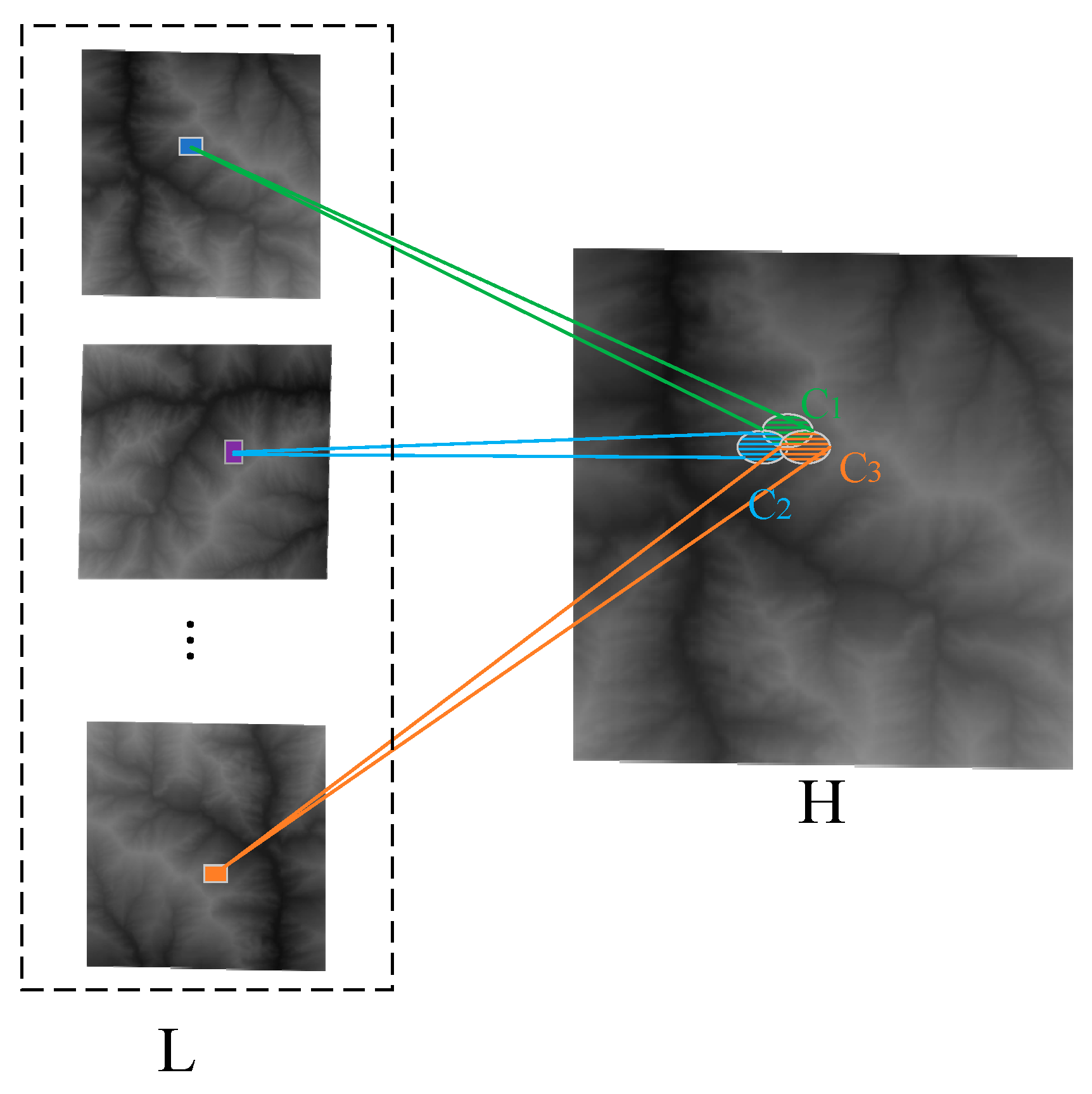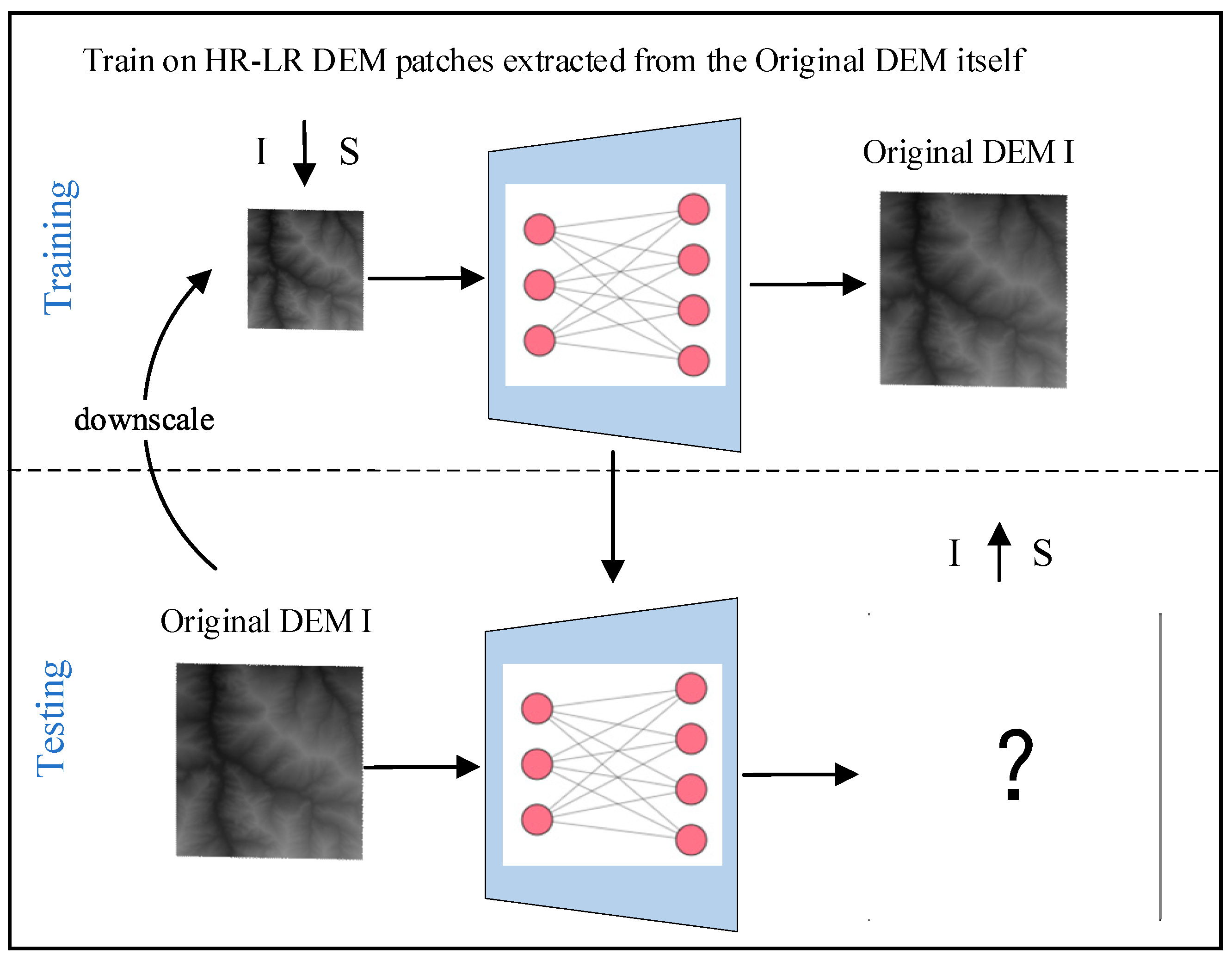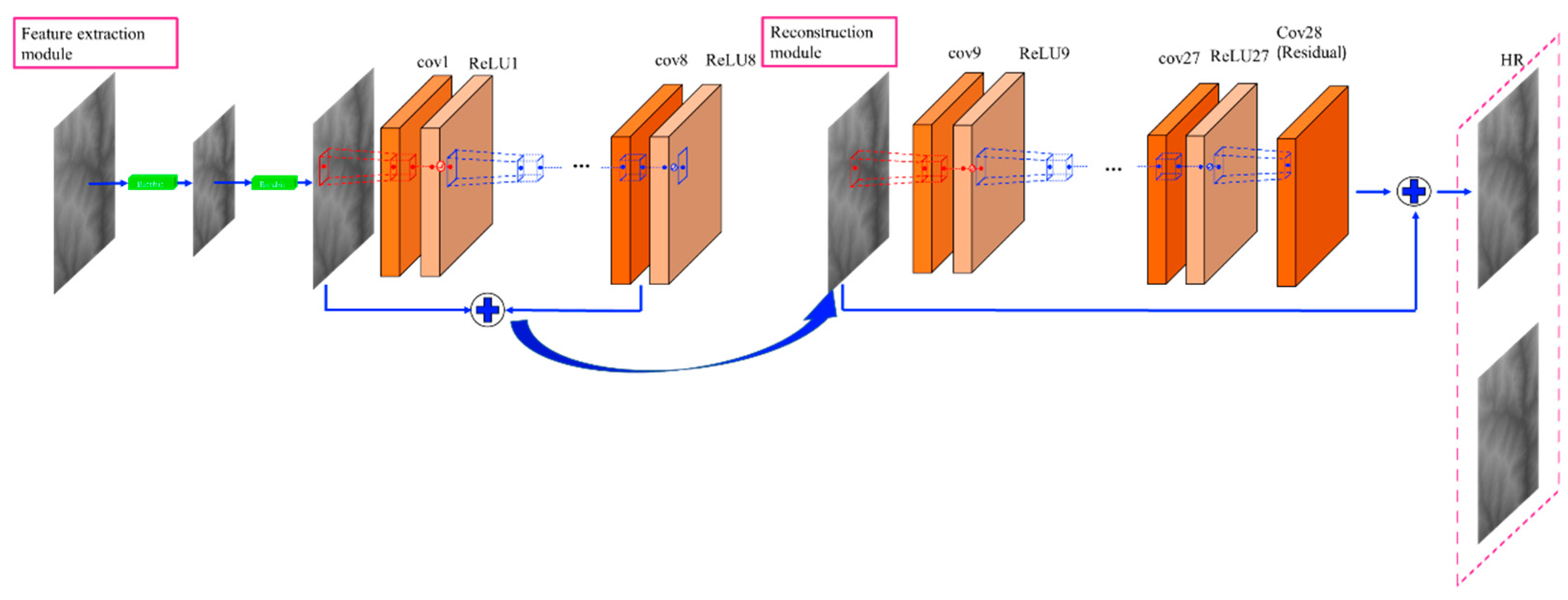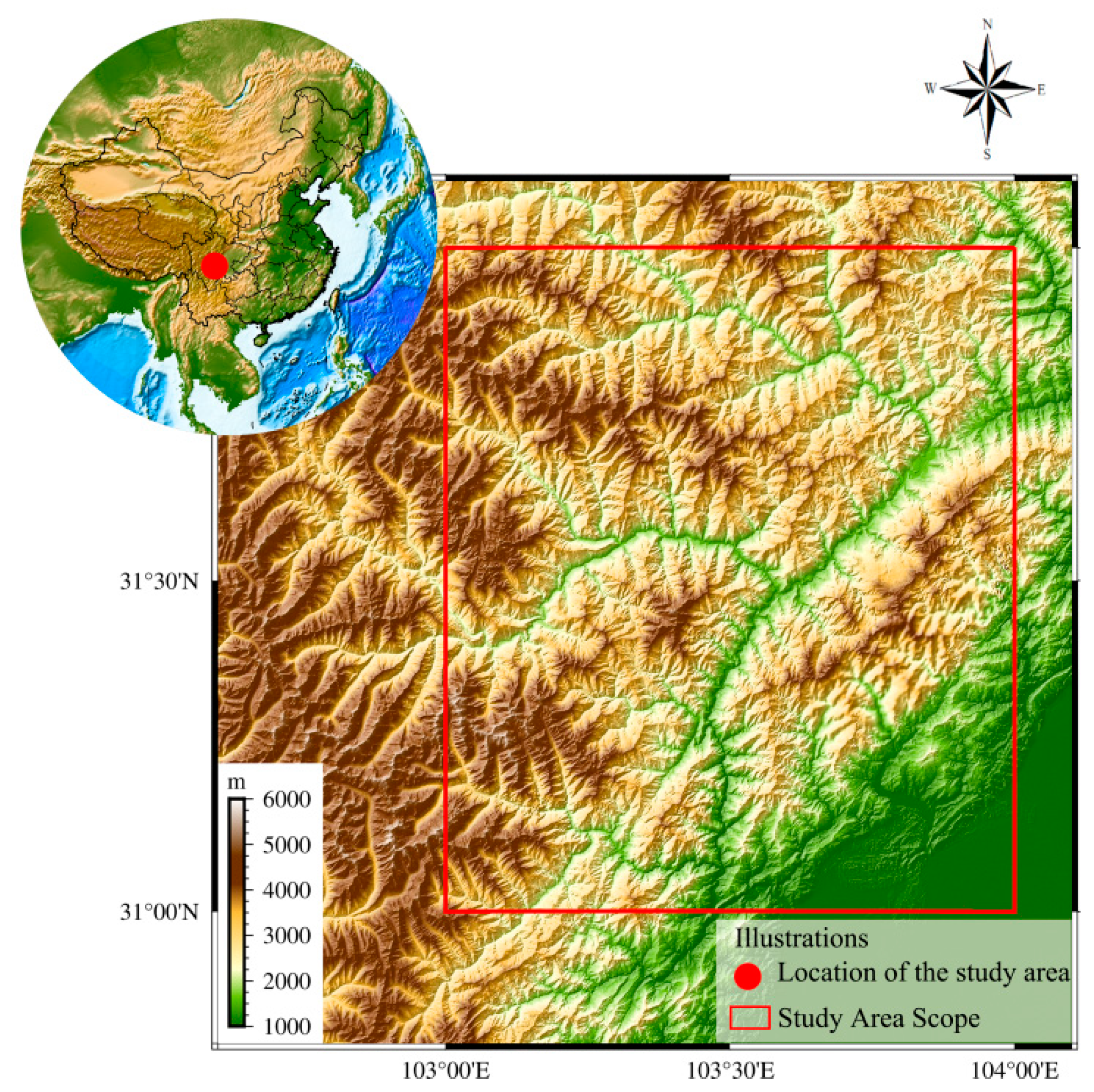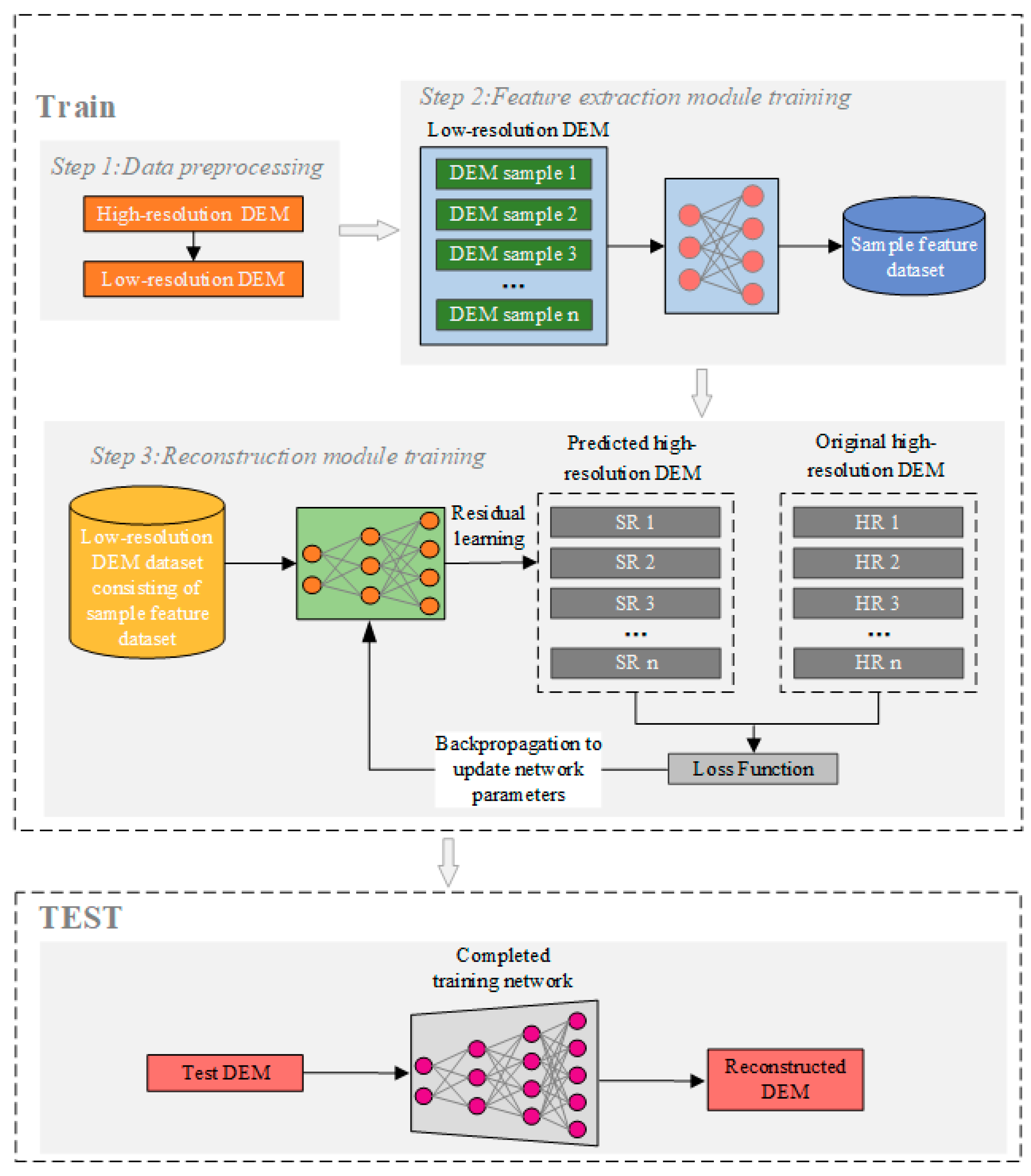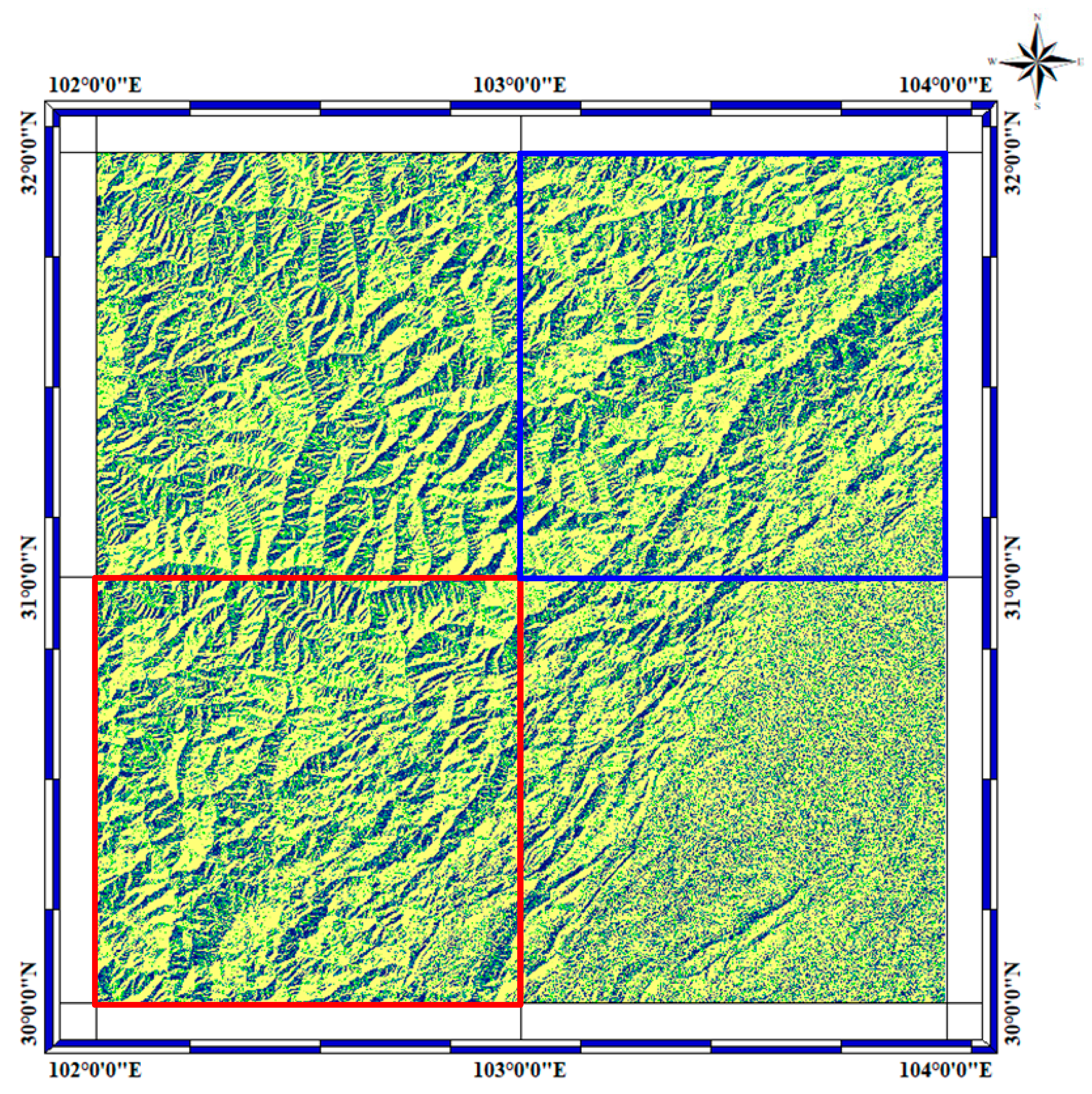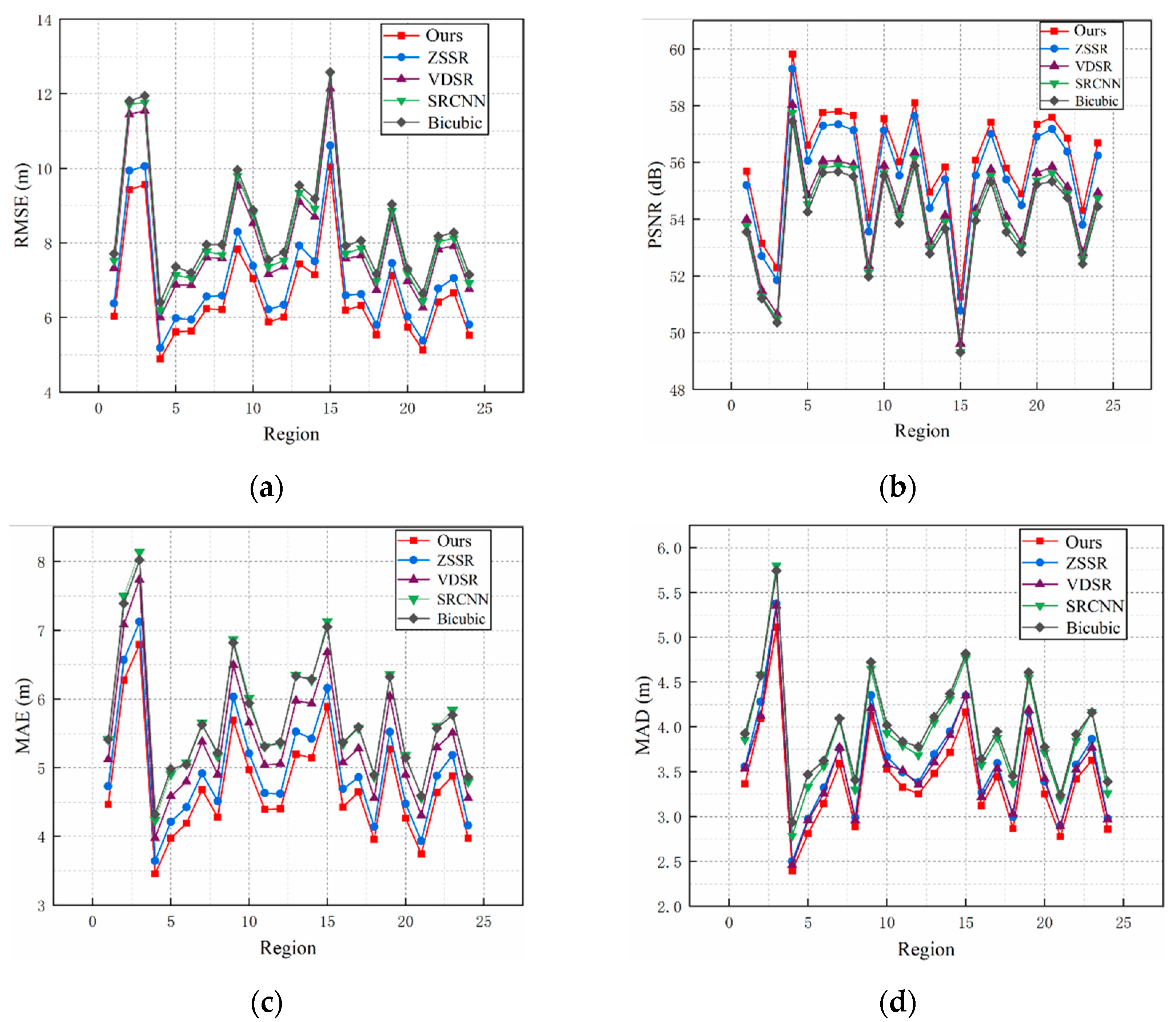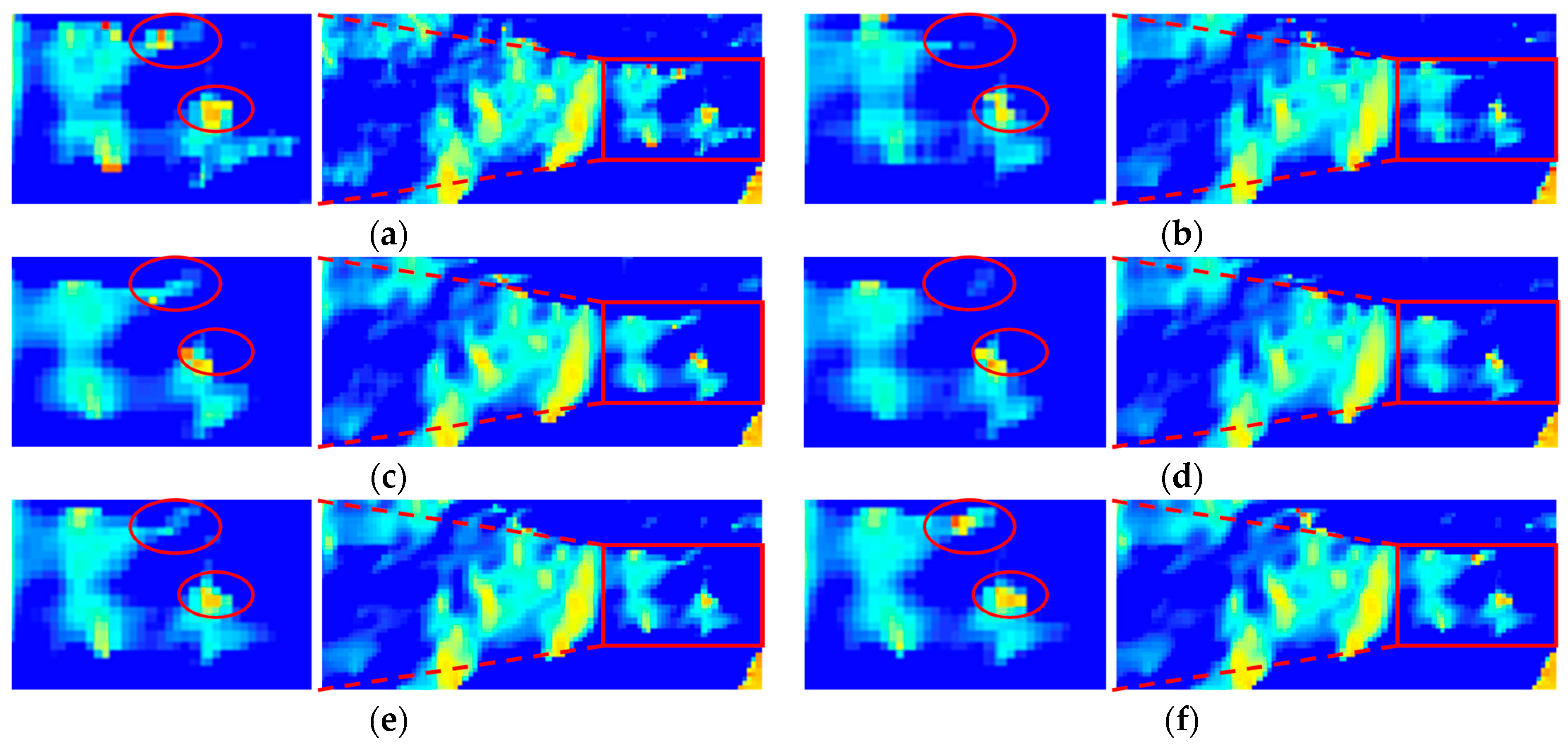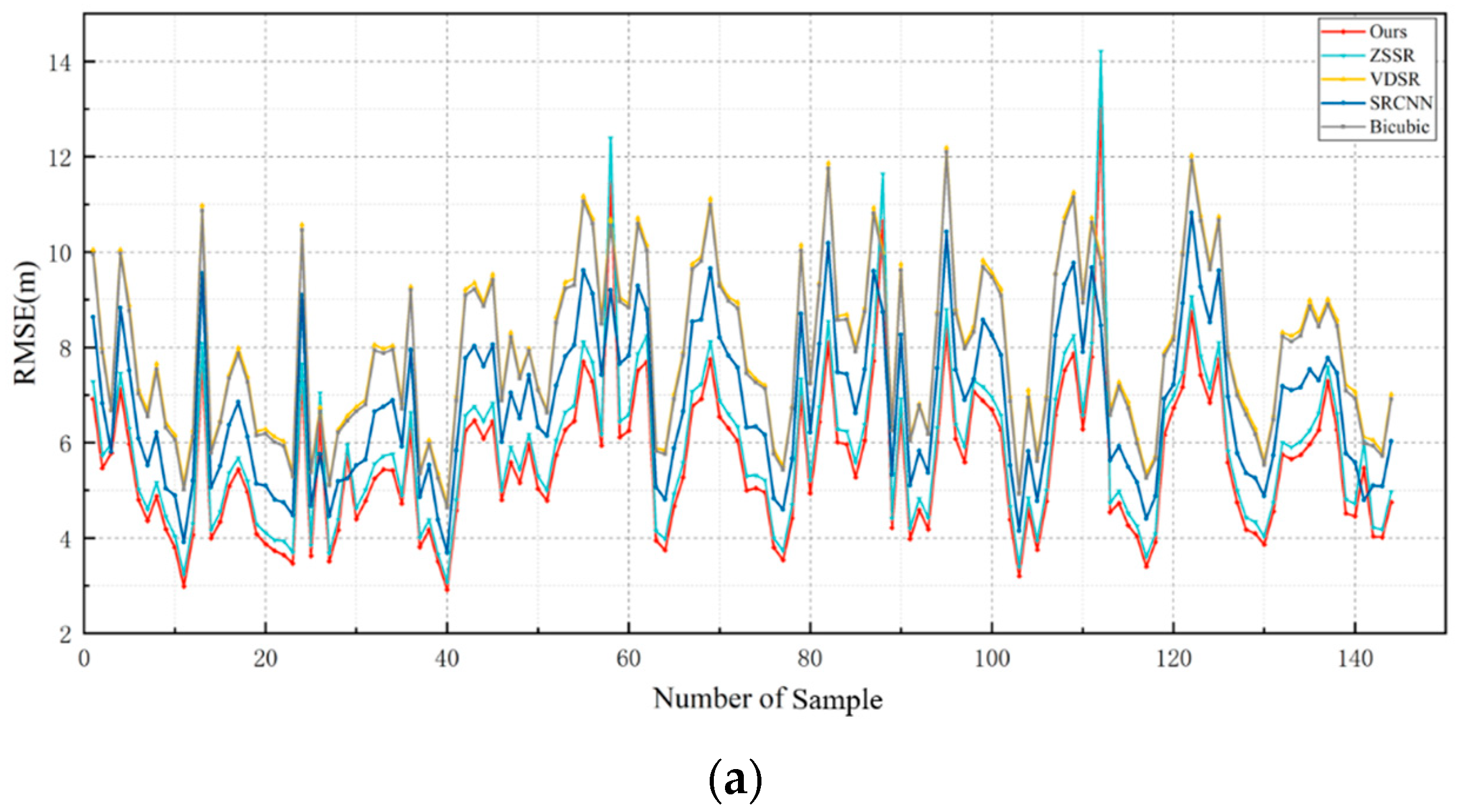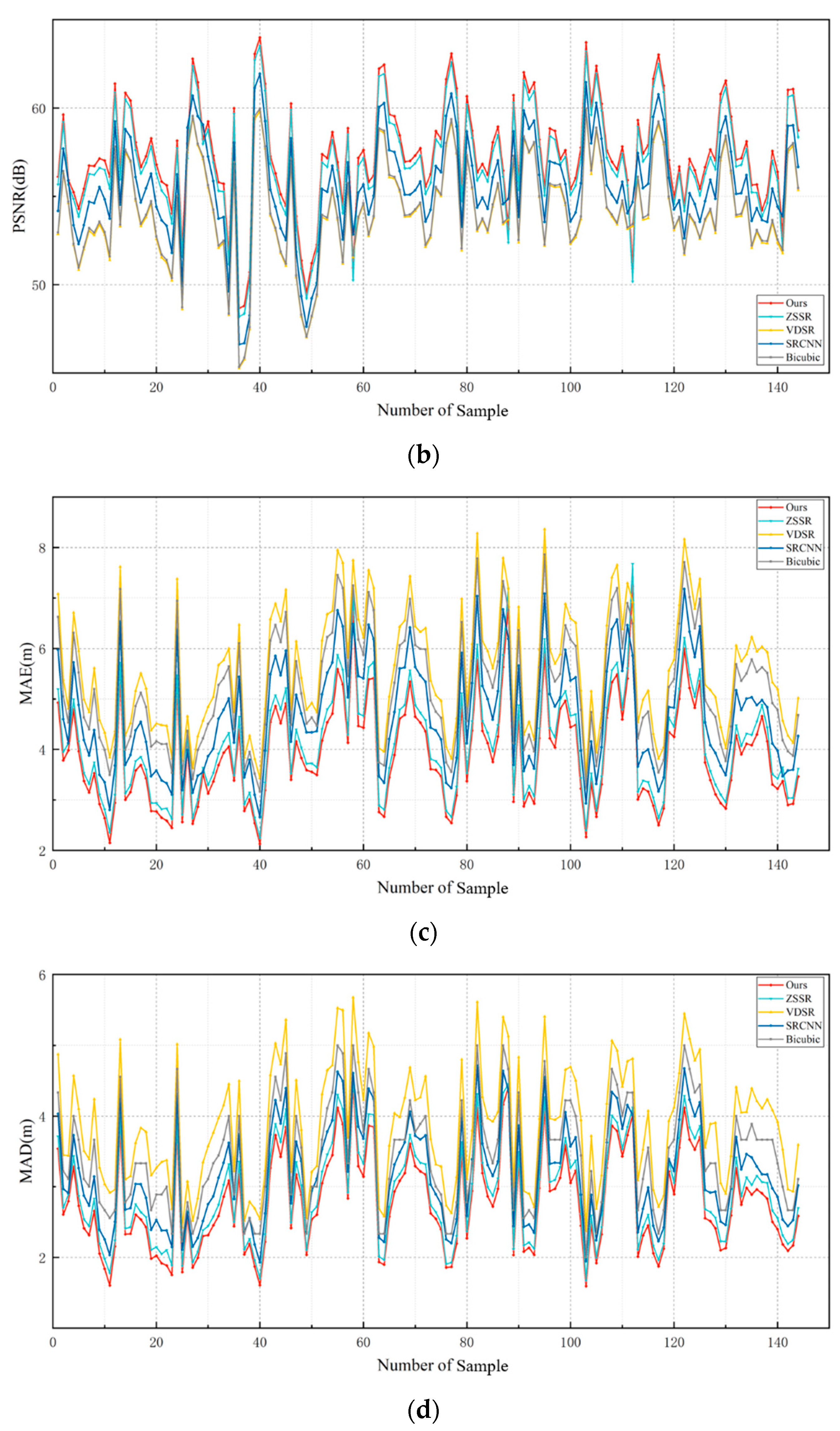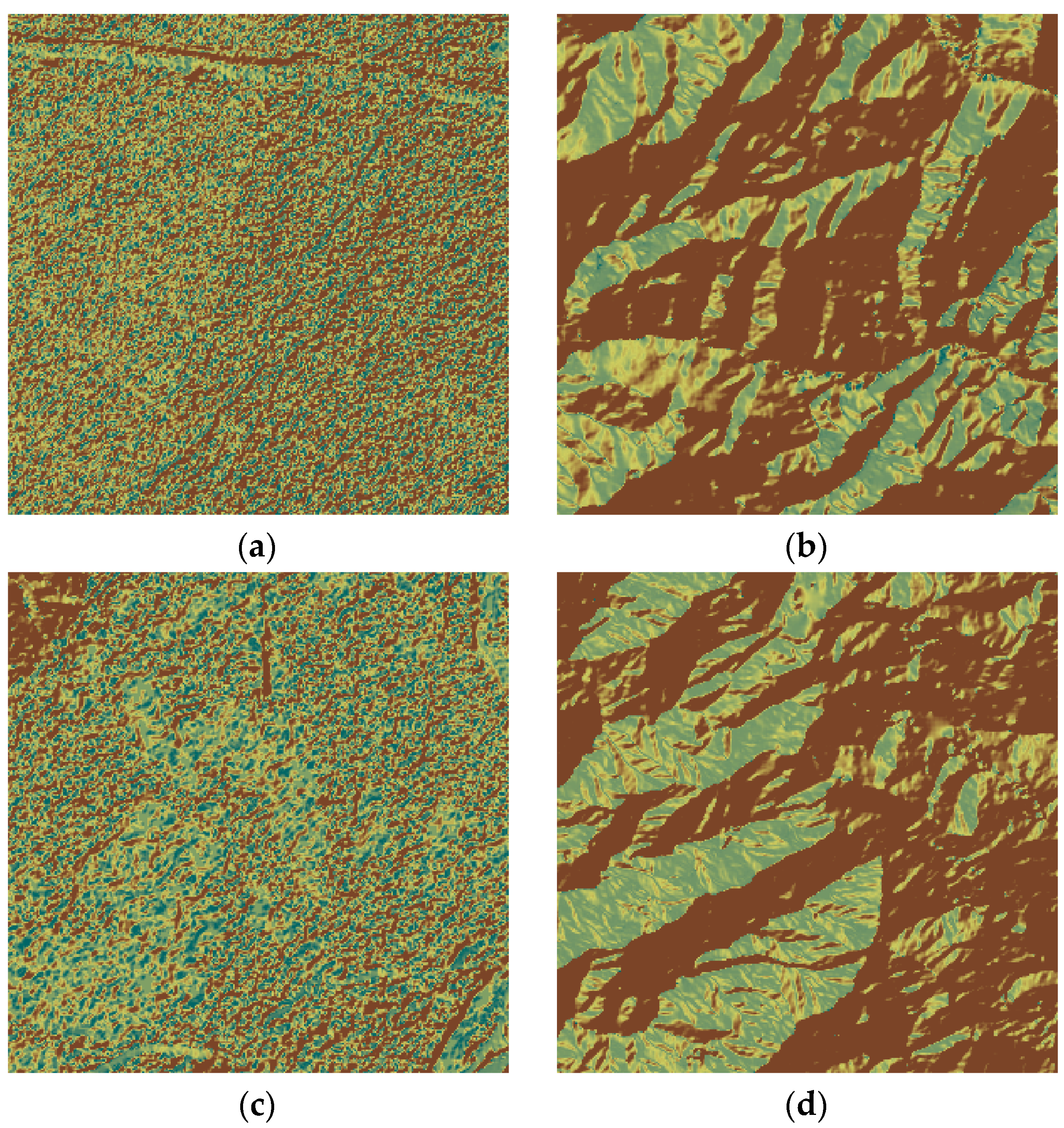4.4.1. Test Dataset in the Training Area
We use the Bicubic method, SRCNN, VDSR, ZSSR, and the new algorithm for each of the DEM super-resolution reconstructions. The bicubic method validates the effect of super-resolution reconstruction with conventional interpolation methods. SRCNN and VDSR validate the effect of super-resolution reconstruction using external DEM datasets separately. ZSSR verifies the effect of super-resolution reconstruction using internal DEM data separately. The new network validates the effect of super-resolution reconstruction when using both internal and external data. The impacts of the five super-resolution reconstruction methods on DEM super-resolution results are compared with those of 90 m super-resolution to 30 m, and the reconstruction results are evaluated by visual and quantitative analysis.
The original DEM and the reconstruction results of the various model optimization algorithms are shown in
Figure 8, which demonstrates the texture detail of the original DEM and the texture detail after reconstruction by different methods.
Figure 8a represents the texture detail of the original DEM.
Figure 8b represents the texture detail of the DEM after the bicubic method.
Figure 8c represents the texture detail of the DEM after SRCNN.
Figure 8d represents the texture detail of the DEM after VDSR.
Figure 8e represents the texture detail of the DEM after ZSSR.
Figure 8f represents the texture detail of the DEM after our methods.
Figure 8a is the original high-resolution DEM, the details of which are used for comparative analysis, and
Figure 8b–f are the reconstruction results of the bicubic method, the reconstruction results of SRCNN, the reconstruction results of VDSR, the reconstruction results of ZSSR, and the reconstruction results of the new method, in that order. In the five reconstructed DEMs, the edges of the reconstructed DEM are blurred and severely rasterized, and they lose some high-frequency information after the bicubic method. The surface of the reconstructed DEM data from SRCNN and VDSR is smooth, with blurred texture features and serious loss in high-frequency information. The reconstructions from ZSSR and our proposed new method are more detailed, as the mountain textures are clearer, and the texture features are closer to those of the original high-resolution DEM than to those of the previous methods. In comparison, our proposed combined internal and external learning DEM super-resolution reconstruction method is richer in inscribed detail than the interpolation-based bicubic DEM super-resolution reconstruction method and the learning-based DEM super-resolution reconstruction methods of external learning alone and internal learning alone. The edge contours are also all close to those of the original high-resolution DEM.
For the quantitative analysis, assuming that the DEM elevation error obeys normal distribution, the super-resolution reconstructed DEM can be measured by Root Mean Square Error (
RMSE), Peak Signal-to-Noise Ratio (
PSNR), Mean Absolute Error (
MAE) and Median Absolute Deviation (
MAD) [
31]. The test dataset is selected from 24 DEM patches within the training area 31°N–32°N, 103°E–104°E. Super-resolution reconstructions are performed on the 24 DEM patches, and the
RMSE,
PSNR,
MAE and
MAD values are calculated for the results of the five DEM super-resolution reconstructions.
The error between the super-resolution reconstructed DEM and the true high-resolution DEM is measured by using the
RMSE.
represents the number of samples, and represents the residual value of DEM elevation. As the value of RMSE becomes smaller, the objective evaluation algorithm predicts the subjective rating value more accurately, the performance of the model is better, and vice versa. The RMSE of the actual image is zero.
- 2.
PSNR
PSNR is a kind of evaluation index based on
MSE. The unit of
PSNR is dB, and larger values mean that the super-resolution reconstructed DEM is more similar to the original high-resolution DEM. Its calculation formula is shown below.
where
represents the maximum value of the original image, Mean Square Error (MSE) is obtained by calculating the difference in elevation values between the super-resolution reconstructed DEM and the original DEM,
denotes the true DEM,
denotes the super-resolution reconstructed DEM and m and n denote, respectively, the number of rows and columns of the DEM image.
- 3.
MAE
MAE is the absolute value of the mean error, and the
MAE is calculated to better reflect the actual situation of the error in the DEM super-resolution reconstruction results.
represents the number of samples, represents the DEM elevation value after super-resolution reconstruction, represents the elevation value of the original high-resolution DEM and represents the DEM elevation residual value.
In addition, considering that error accuracy is affected by outliers and the non-normal distribution of errors, robust statistical methods are considered in the evaluation of DEM accuracy.
- 4.
MAD
MAD is a robust statistic. For
MAD, when there are a small number of outliers in the data, it does not affect the statistical results, avoiding the influence of outliers on the statistical accuracy of errors.
denotes the DEM elevation residuals, and
denotes the median of the elevation values. The calculation process is as follows.
We quantify the analysis using four metrics:
RMSE,
PSNR,
MSE and
MAD. The results of the
RMSE measure are shown in
Table 1. Smaller values of
RMSE indicate a better reconstruction effect, and
Figure 9 ais a visual representation of the results. As can be seen from the table, among the five DEM super-resolution reconstruction methods, the
RMSE value of the reconstruction result of the DEM super-resolution reconstruction method based on a combination of internal and external learning that we propose is the smallest. Compared with the reconstruction results of the interpolation-based bicubic super-resolution reconstruction method, the reconstruction results are improve by 21.6%. Compared to the reconstruction results of the super-resolution reconstruction methods SRCNN and VDSR based on external learning in deep learning, the reconstruction results are improve by 19.9% and 17.8%, respectively. The reconstruction results improve by 5.3% compared to those of ZSSR, a super-resolution reconstruction method based on internal learning in deep learning.
The quantified results of
PSNR are shown in
Table 2. As the
PSNR value becomes larger, the reconstruction effect becomes better.
Figure 9 bis a visual representation of the results. From the table, it can be seen that, among the five DEM super-resolution reconstruction methods, the DEM super-resolution reconstruction method based on a combination of internal and external learning that we propose has the largest value of
PSNR for the reconstruction results. Compared with the reconstruction result of the interpolation-based bicubic super-resolution reconstruction method, the reconstruction result is improve by 4.0%. Compared to the reconstruction results of the super-resolution reconstruction methods SRCNN and VDSR, which are based on external learning in deep learning, the reconstruction results improve by 3.6% and 3.2%, respectively. The reconstruction results improve by 0.9% compared to those of ZSSR, a super-resolution reconstruction method based on internal learning in deep learning.
The quantified results of
MAE are shown in
Table 3. As the value of
MAE becomes smaller, the reconstruction effect becomes better.
Figure 9c is a visual representation of the results. From the table, it can be seen that, among the five DEM super-resolution reconstruction methods, our proposed DEM super-resolution reconstruction method based on a combination of internal and external learning has the smallest value of
MAE for the reconstruction results. Compared with the reconstruction result of the interpolation-based bicubic super-resolution reconstruction method, the reconstruction result is improved by 17.3%. Compared to the reconstruction results of the super-resolution reconstruction methods SRCNN and VDSR based on external learning in deep learning, the reconstruction results are improved by 17.5% and 12.7%, respectively. The reconstruction results improve by 5.0% compared to those of ZSSR, a super-resolution reconstruction method based on internal learning in deep learning.
The quantified results of
MAD are shown in
Table 4, where smaller values of
MAD indicate better reconstruction results.
Figure 9d is a visual representation of the results. From the table, it can be seen that, among the five DEM super-resolution reconstruction methods, our proposed internal-learning-based and external learning-based DEM super-resolution reconstruction method has the smallest value of
MAD for the reconstruction results. The reconstruction result is improved by 13.8% compared to that of the interpolation-based bicubic super-resolution reconstruction method. Compared to the reconstruction results of the super-resolution reconstruction methods SRCNN and VDSR based on external learning in deep learning, the reconstruction results are improved by 12.5% and 3.7%, respectively. The reconstruction results improve by 4.7% compared to those of ZSSR, a super-resolution reconstruction method based on internal learning in deep learning.
4.4.2. Test Dataset Unrelated to the Training Set
In order to verify the generalization ability of the model and to avoid a correlation between the training and validation data, a region from 30°N to 31°N and from 102°E to 103°E is selected as the dataset outside the training area for the validation of the model. Similarly, we crop the region into 144 sheets of size 300 × 300 DEM patches to validate the generalization ability of bicubic interpolation, SRCNN, VDSR, ZSSR and our proposed new method in turn.
As shown in
Figure 10,
Figure 10a represents the original high-resolution DEM,
Figure 10b represents the result of super-resolution reconstruction of the DEM based on the bicubic interpolation method,
Figure 10c represents the result of super-resolution reconstruction of the DEM based on the external learning super-resolution reconstruction method SRCNN,
Figure 10d represents the result of super-resolution reconstruction of the DEM based on the external learning super-resolution reconstruction method VDSR,
Figure 10e represents the result of super-resolution reconstruction of the DEM based on the internal learning super-resolution reconstruction method ZSSR and
Figure 10f represents the result of super-resolution reconstruction of the DEM of our proposed combined internal learning and external learning super-resolution reconstruction method. From the visual evaluation we can see that the super-resolution reconstruction results of the interpolation-based bicubic DEM super-resolution reconstruction method lose more high-frequency information and show too smooth in the terrain. Among the learning-based super-resolution reconstruction methods, the super-resolution reconstruction results of SRCNN and VDSR have insignificant texture features and lose more detail information compared with the original high-resolution DEM. Among the learning-based super-resolution reconstruction methods, the results of super-resolution reconstruction by ZSSR are significantly better than the bicubic method, SRCNN and VDSR regarding their visual evaluation. Compared with several other DEM super-resolution reconstruction methods, our proposed combined internal learning and external learning DEM super-resolution reconstruction method is able to better recover the texture details of the DEM. The texture features are the richest compared to several other DEM super-resolution reconstruction methods and are closest to those of the original high-resolution DEM.
Similarly, we quantify the analysis using four metrics:
RMSE,
PSNR,
MSE and
MAD. From
Table 5,
Table 6,
Table 7 and
Table 8, it can be seen that, among the learning-based super-resolution reconstruction methods, the VDSR algorithm has poor network generalization capability for super-resolution reconstruction of the DEM. The VDSR algorithm is less effective for super-resolution reconstruction of the test set outside the training area, whereas ZSSR and the proposed method of combined internal and external learning for DEM super-resolution reconstruction in this paper achieve better reconstruction results for both the test area within and outside the training area. The test area is selected from 30°N–31°N, 102°E–103°E. The area is divided into 144 DEM patches, and the
RMSE,
PSNR,
MAE and
MAD values are calculated for each of these 144 DEM patches.
The test area is divided into 144 patches, and the average value of their
RMSE results is shown in
Table 5. Smaller values of
RMSE indicate a better reconstruction effect, and
Figure 11a is a visual representation of the
RMSE values of the 144 DEM patches. As can be seen from the table, among the five DEM super-resolution reconstruction methods, our proposed DEM super-resolution reconstruction method based on a combination of internal and external learning has the smallest value of
RMSE for the reconstruction result, with an improvement of 29.1% compared to the reconstruction result of the interpolation-based bicubic super-resolution reconstruction method. The reconstruction results are 17.7% and 30.0% better than those of SRCNN and VDSR, respectively, which are super-resolution reconstruction methods based on external learning in deep learning, and the results are 5.1% better than those of ZSSR, a super-resolution reconstruction method based on internal learning in deep learning.
The average of the quantified results of the
PSNR of the 144 DEMs in the test area is shown in
Table 6. Larger
PSNR values indicate a better reconstruction effect, and
Figure 11b is a visual representation of the validation results for the 144 DEM patches. As can be seen from the table, among the five DEM super-resolution reconstruction methods, our proposed DEM super-resolution reconstruction method based on a combination of internal and external learning has the largest value of
PSNR for the reconstruction results, with an improvement of 5.7% compared to the reconstruction results of the interpolation-based bicubic super-resolution reconstruction method and an improvement of 3.2% and 5.9% compared to the reconstruction results of the super-resolution reconstruction methods SRCNN and VDSR, respectively, which are based on external learning in deep learning. The reconstruction results are improved by 0.9% compared to those of ZSSR, a super-resolution reconstruction method based on internal learning in deep learning.
The average of the quantified results of
MAE for the 144 DEMs in the test area is shown in
Table 7. Smaller
MAE values indicate a better reconstruction effect, and
Figure 11c is a visual representation of the validation results for the 144 DEM patches. As can be seen from the table, among the five DEM super-resolution reconstruction methods, our proposed DEM super-resolution reconstruction method based on a combination of internal and external learning has the smallest value of
MAE for the reconstruction results. Compared with the reconstruction results of the interpolation-based bicubic super-resolution reconstruction method, the reconstruction results of the super-resolution reconstruction methods SRCNN and VDSR, which are based on external learning in deep learning, improve by 25.0%, 17.0% and 30.4%, respectively. The reconstruction results of the super-resolution reconstruction method ZSSR, which is based on internal learning in deep learning, improve by 4.9%.
In order to avoid the influence of outliers and systematic errors on evaluation results, the robust estimation method of
MAD is used to evaluate the 144 DEM patches in the test area, and the average value of the quantified results of their
MAD is shown in
Table 8. Smaller
MAE values indicate better reconstruction.
Figure 11d is a visual representation of the validation results for 144 small regions. As can be seen from the table, our proposed DEM super-resolution reconstruction method based on a combination of internal and external learning has the smallest value of
MAD for the reconstruction results among the five DEM super-resolution reconstruction methods. The reconstruction results are improved by 20.0% compared to those of the interpolation-based bicubic super-resolution reconstruction method. Compared to the reconstruction results of SRCNN and VDSR, which are based on external learning in deep learning, the reconstruction results improve by 12.5% and 28.2%, respectively. The reconstruction results improve by 3.5% compared to those of ZSSR, a super-resolution reconstruction method based on internal learning in deep learning.
